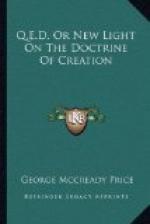And probably we shall never be able to learn any more than this. We have arrived at a sort of box-within-a-box theory of the make-up of matter. By a very elaborate system of unpacking, or by some violent external force that makes the inside burst open, as it were, we seem to be able to make pieces fly off from the atoms, these pieces being then projected into space with enormous force and velocity. There are theories galore of the structure of the atom; but as Prof. E.P. Lewis has said, most of these theories are so impossible as to be absurd, or so speculative that “they suggest no experimental tests for their validity."[2] Just at present Rutherford’s theory of the structure of the atom is quite popular. This postulates a nucleus composed of a group of positive units and electrons, with an excess of the positive charges equal to half the atomic weight, with an equal number of electrons circulating about this nucleus in rings. Bohr’s theory, which is not very different from this, has perhaps even more friends, and it is supported by the remarkable discoveries of the lamented Moseley. But we must not take such theories too seriously. As Kayser has said, any true theory of the make-up of the atoms must assume an absolutely full and perfect knowledge of all electrical and optical processes, and is therefore beyond our dreams. Or as Professor Planck said in his Columbia lectures, we are not entitled to hope that we shall ever be able to represent truly through any physical formulae the internal structure of the atom.
[Footnote 2: Nature, April 5, 1917.]
III
2. We must now take up the second phase of our subject, the problem of the origin of matter.
Before we knew anything of radioactivity we could have dismissed such a subject briefly by quoting the law of the conservation of matter, which says that matter can neither be created nor destroyed by any means known to science. By our knowledge of radioactivity we can make our answer a little more learned, a little less abrupt, but none the less discouraging to the advocate of the development hypothesis. We can tell how the elements of high atomic weight, such as uranium and thorium, are constantly giving off particles and are thus by loss or decomposition being changed over into other elements, such as radium, niton, polonium and lead. But our new knowledge compels us ultimately to give the same answer as before, namely, that we still do not know how matter ever could have originated, except that “in the beginning” it was called into existence by the fiat of Him whom we Christians worship as our God, the Creator. Thus we reach the conception of the universe as that of a great clock gradually running down, which is certainly the antithesis of that picture so long held before us by the advocates of the development theory.




